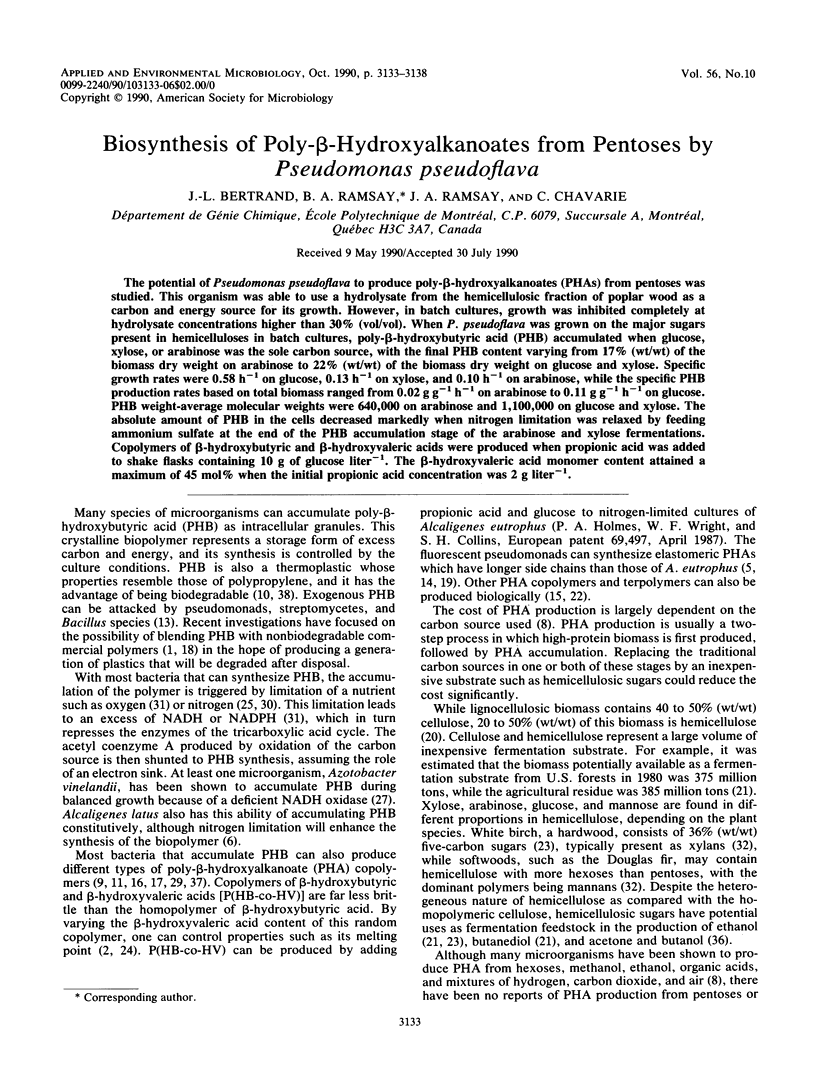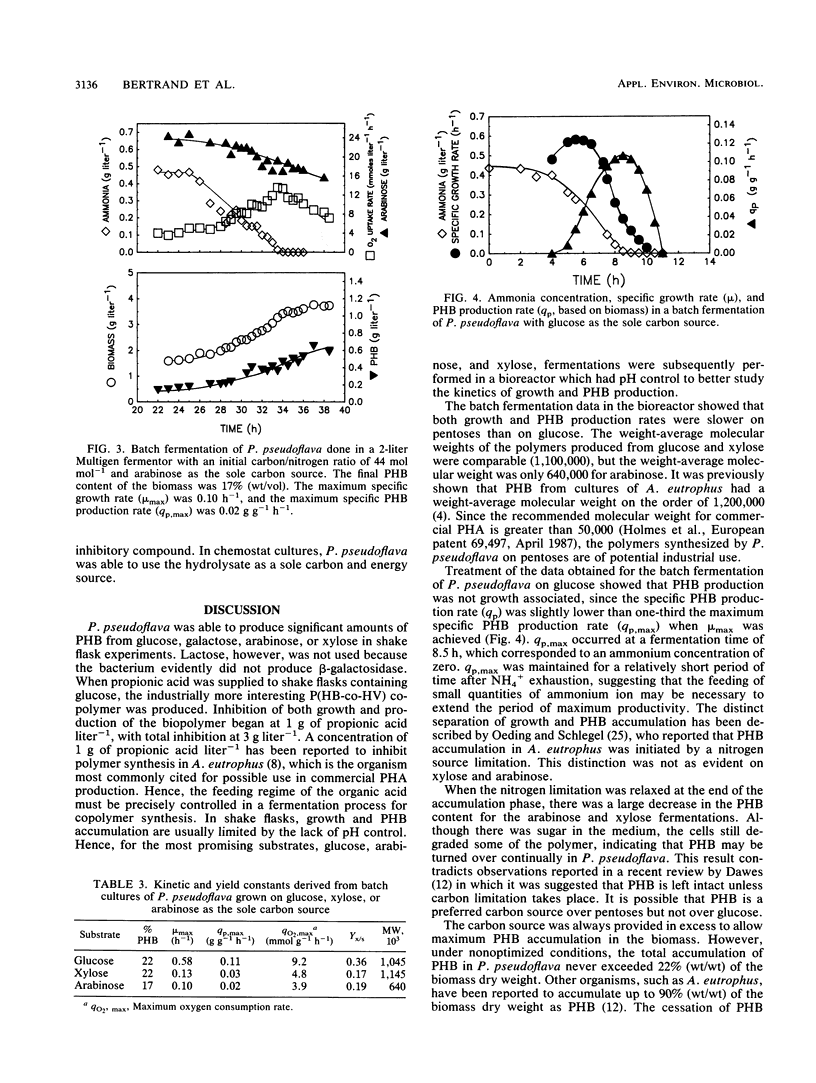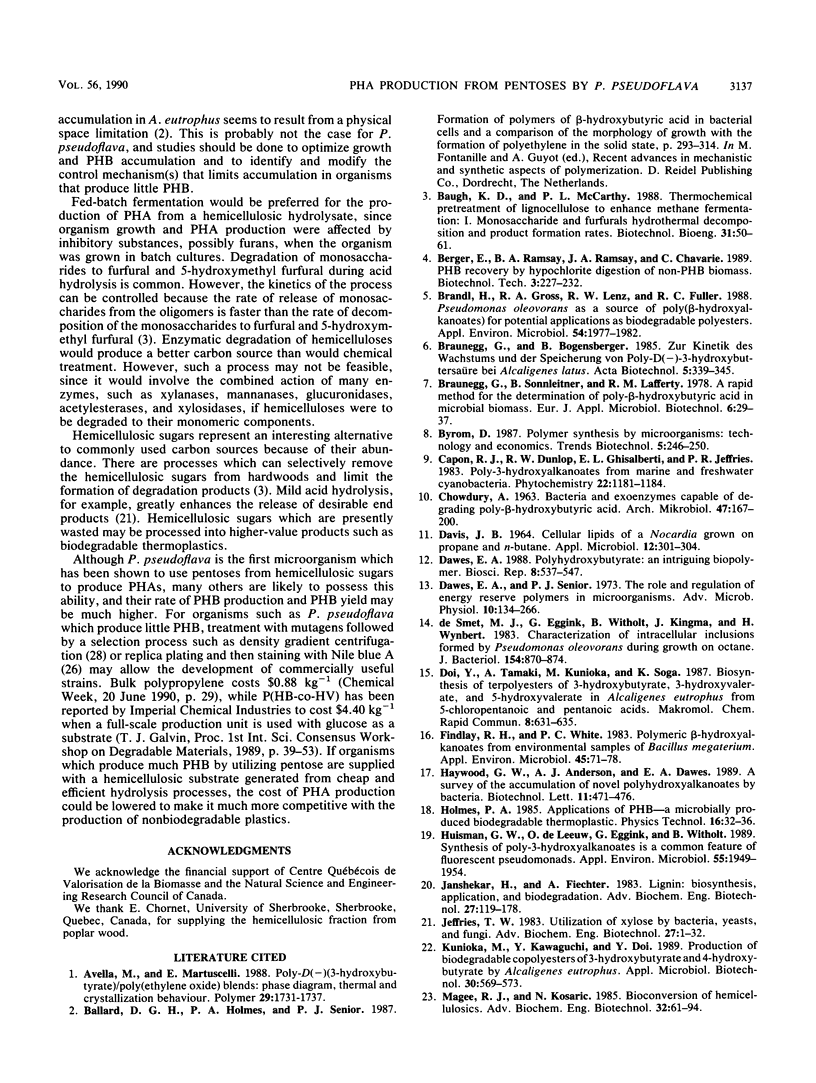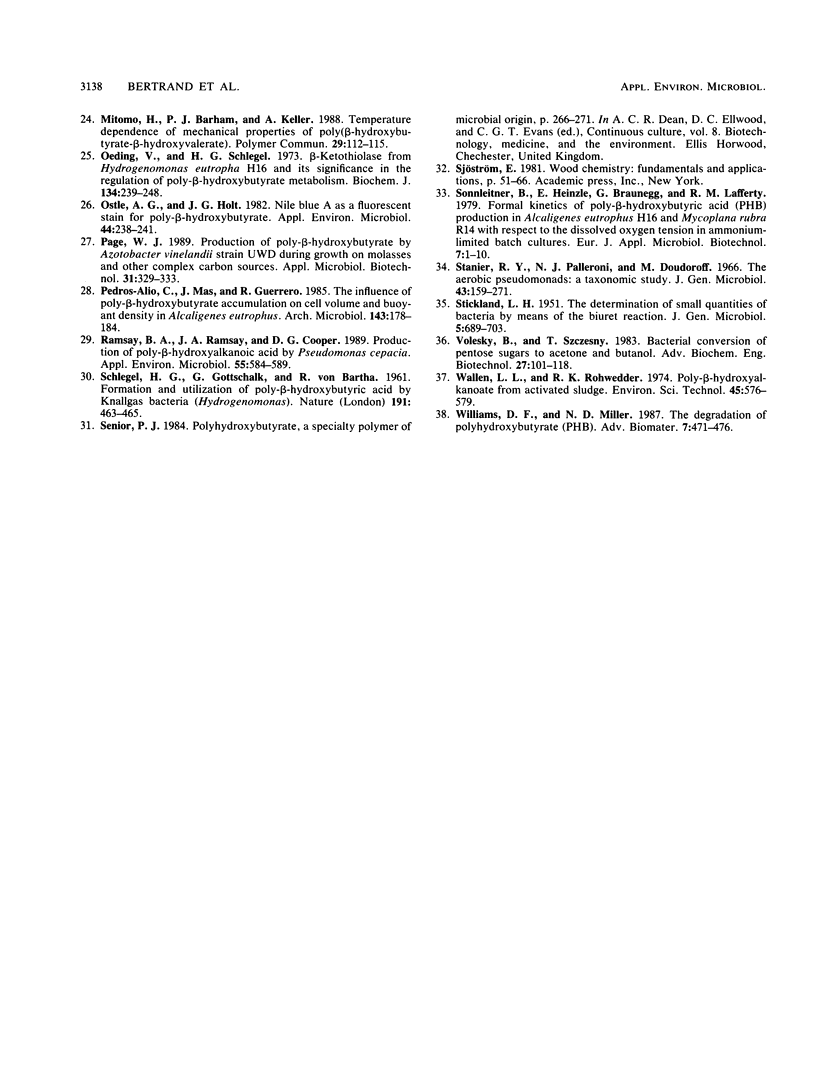Abstract
The potential of Pseudomonas pseudoflava to produce poly-β-hydroxyalkanoates (PHAs) from pentoses was studied. This organism was able to use a hydrolysate from the hemicellulosic fraction of poplar wood as a carbon and energy source for its growth. However, in batch cultures, growth was inhibited completely at hydrolysate concentrations higher than 30% (vol/vol). When P. pseudoflava was grown on the major sugars present in hemicelluloses in batch cultures, poly-β-hydroxybutyric acid (PHB) accumulated when glucose, xylose, or arabinose was the sole carbon source, with the final PHB content varying from 17% (wt/wt) of the biomass dry weight on arabinose to 22% (wt/wt) of the biomass dry weight on glucose and xylose. Specific growth rates were 0.58 h−1 on glucose, 0.13 h−1 on xylose, and 0.10 h−1 on arabinose, while the specific PHB production rates based on total biomass ranged from 0.02 g g−1 h−1 on arabinose to 0.11 g g−1 h−1 on glucose. PHB weight-average molecular weights were 640,000 on arabinose and 1,100,000 on glucose and xylose. The absolute amount of PHB in the cells decreased markedly when nitrogen limitation was relaxed by feeding ammonium sulfate at the end of the PHB accumulation stage of the arabinose and xylose fermentations. Copolymers of β-hydroxybutyric and β-hydroxyvaleric acids were produced when propionic acid was added to shake flasks containing 10 g of glucose liter−1. The β-hydroxyvaleric acid monomer content attained a maximum of 45 mol% when the initial propionic acid concentration was 2 g liter−1.
Full text
PDF





Selected References
These references are in PubMed. This may not be the complete list of references from this article.
- Bayer-Berger M. M., Ravussin P., Fankhauser H., Freeman J. Effect of three pretreatment techniques on hemodynamic and CSFP responses to skull-pin head-holder application during thiopentone/isoflurane or propofol anesthesia. J Neurosurg Anesthesiol. 1989 Sep;1(3):227–232. doi: 10.1097/00008506-198909000-00004. [DOI] [PubMed] [Google Scholar]
- Brandl H., Gross R. A., Lenz R. W., Fuller R. C. Pseudomonas oleovorans as a Source of Poly(beta-Hydroxyalkanoates) for Potential Applications as Biodegradable Polyesters. Appl Environ Microbiol. 1988 Aug;54(8):1977–1982. doi: 10.1128/aem.54.8.1977-1982.1988. [DOI] [PMC free article] [PubMed] [Google Scholar]
- CHOWDHURY A. A. POLY-BETA-HYDROXYBUTTERSAEURE ABBAUENDE BAKTERIEN UND EXOENZYM. Arch Mikrobiol. 1963 Dec 10;47:167–200. [PubMed] [Google Scholar]
- DAVIS J. B. CELLULAR LIPIDS OF A NOCARDIA GROWN ON PROPANE AND N-BUTANE. Appl Microbiol. 1964 Jul;12:301–304. doi: 10.1128/am.12.4.301-304.1964. [DOI] [PMC free article] [PubMed] [Google Scholar]
- Dawes E. A. Polyhydroxybutyrate: an intriguing biopolymer. Biosci Rep. 1988 Dec;8(6):537–547. doi: 10.1007/BF01117332. [DOI] [PubMed] [Google Scholar]
- Dawes E. A., Senior P. J. The role and regulation of energy reserve polymers in micro-organisms. Adv Microb Physiol. 1973;10:135–266. doi: 10.1016/s0065-2911(08)60088-0. [DOI] [PubMed] [Google Scholar]
- Findlay R. H., White D. C. Polymeric Beta-Hydroxyalkanoates from Environmental Samples and Bacillus megaterium. Appl Environ Microbiol. 1983 Jan;45(1):71–78. doi: 10.1128/aem.45.1.71-78.1983. [DOI] [PMC free article] [PubMed] [Google Scholar]
- Huisman G. W., de Leeuw O., Eggink G., Witholt B. Synthesis of poly-3-hydroxyalkanoates is a common feature of fluorescent pseudomonads. Appl Environ Microbiol. 1989 Aug;55(8):1949–1954. doi: 10.1128/aem.55.8.1949-1954.1989. [DOI] [PMC free article] [PubMed] [Google Scholar]
- Janshekar H., Fiechter A. Lignin: biosynthesis, application, and biodegradation. Adv Biochem Eng Biotechnol. 1983;27:119–178. doi: 10.1007/BFb0009107. [DOI] [PubMed] [Google Scholar]
- Jeffries T. W. Utilization of xylose by bacteria, yeasts, and fungi. Adv Biochem Eng Biotechnol. 1983;27:1–32. doi: 10.1007/BFb0009101. [DOI] [PubMed] [Google Scholar]
- Magee R. J., Kosaric N. Bioconversion of hemicellulosics. Adv Biochem Eng Biotechnol. 1985;32:61–93. doi: 10.1007/BFb0009525. [DOI] [PubMed] [Google Scholar]
- Oeding V., Schlegel H. G. Beta-ketothiolase from Hydrogenomonas eutropha H16 and its significance in the regulation of poly-beta-hydroxybutyrate metabolism. Biochem J. 1973 May;134(1):239–248. doi: 10.1042/bj1340239. [DOI] [PMC free article] [PubMed] [Google Scholar]
- Ostle A. G., Holt J. G. Nile blue A as a fluorescent stain for poly-beta-hydroxybutyrate. Appl Environ Microbiol. 1982 Jul;44(1):238–241. doi: 10.1128/aem.44.1.238-241.1982. [DOI] [PMC free article] [PubMed] [Google Scholar]
- Ramsay B. A., Ramsay J. A., Cooper D. G. Production of Poly-beta-Hydroxyalkanoic Acid by Pseudomonas cepacia. Appl Environ Microbiol. 1989 Mar;55(3):584–589. doi: 10.1128/aem.55.3.584-589.1989. [DOI] [PMC free article] [PubMed] [Google Scholar]
- SCHLEGEL H. G., GOTTSCHALK G., VON BARTHA R. Formation and utilization of poly-beta-hydroxybutyric acid by Knallgas bacteria (Hydrogenomonas). Nature. 1961 Jul 29;191:463–465. doi: 10.1038/191463a0. [DOI] [PubMed] [Google Scholar]
- STICKLAND L. H. The determination of small quantities of bacteria by means of the biuret reaction. J Gen Microbiol. 1951 Oct;5(4):698–703. doi: 10.1099/00221287-5-4-698. [DOI] [PubMed] [Google Scholar]
- Stanier R. Y., Palleroni N. J., Doudoroff M. The aerobic pseudomonads: a taxonomic study. J Gen Microbiol. 1966 May;43(2):159–271. doi: 10.1099/00221287-43-2-159. [DOI] [PubMed] [Google Scholar]
- Volesky B., Szczesny T. Bacterial conversion of pentose sugars to acetone and butanol. Adv Biochem Eng Biotechnol. 1983;27:101–118. doi: 10.1007/BFb0009106. [DOI] [PubMed] [Google Scholar]
- de Smet M. J., Eggink G., Witholt B., Kingma J., Wynberg H. Characterization of intracellular inclusions formed by Pseudomonas oleovorans during growth on octane. J Bacteriol. 1983 May;154(2):870–878. doi: 10.1128/jb.154.2.870-878.1983. [DOI] [PMC free article] [PubMed] [Google Scholar]


